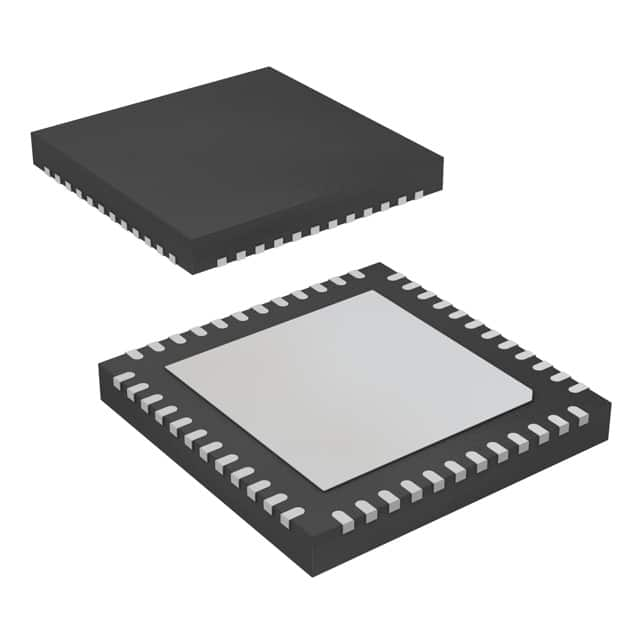ADS61B49IRGZR
Product Overview
Category: Integrated Circuit (IC)
Use: The ADS61B49IRGZR is a high-speed analog-to-digital converter (ADC) designed for precision data acquisition applications. It provides accurate conversion of analog signals into digital format, enabling precise measurement and analysis.
Characteristics: - High-speed sampling rate - High resolution - Low power consumption - Wide input voltage range - Differential inputs - Built-in digital signal processing capabilities
Package: The ADS61B49IRGZR comes in a small form factor package, making it suitable for space-constrained applications. It is available in a 48-pin VQFN (Very Thin Quad Flat No-Lead) package.
Essence: The essence of the ADS61B49IRGZR lies in its ability to convert analog signals with high accuracy and speed, providing reliable digital data for further processing and analysis.
Packaging/Quantity: The ADS61B49IRGZR is typically sold in reels containing multiple units. The exact quantity per reel may vary depending on the supplier.
Specifications
- Resolution: 16 bits
- Sampling Rate: Up to 250 Mega Samples Per Second (MSPS)
- Input Voltage Range: ±2 V
- Power Supply: 3.3 V
- Operating Temperature Range: -40°C to +85°C
- Interface: Serial Peripheral Interface (SPI)
Detailed Pin Configuration
The ADS61B49IRGZR has a total of 48 pins. Here is a detailed pin configuration:
- VREFP: Positive reference voltage input
- VREFN: Negative reference voltage input
- AVDD: Analog power supply
- DVDD: Digital power supply
- AGND: Analog ground
- DGND: Digital ground
- CLK: Clock input
- CS: Chip select input
- SDI: Serial data input
- SDO: Serial data output
- SCLK: Serial clock input
- RESET: Reset input 13-28: Differential analog input pins (AIN0+ to AIN7-) 29-48: Not connected (NC)
Functional Features
- High-Speed Conversion: The ADS61B49IRGZR offers a high sampling rate of up to 250 MSPS, allowing for precise capture of fast-changing analog signals.
- High Resolution: With a resolution of 16 bits, it provides accurate representation of the input signal, enabling detailed analysis and measurement.
- Low Power Consumption: The ADC is designed to operate with low power consumption, making it suitable for battery-powered applications or energy-efficient systems.
- Digital Signal Processing: The built-in digital signal processing capabilities allow for real-time data manipulation and filtering, reducing the need for external processing components.
Advantages and Disadvantages
Advantages: - High-speed conversion enables accurate capture of fast-changing signals. - High resolution provides detailed representation of the input signal. - Low power consumption makes it suitable for portable and energy-efficient applications. - Built-in digital signal processing reduces the need for external components.
Disadvantages: - Limited input voltage range may not be suitable for applications requiring higher voltage levels. - Requires an external clock source for operation.
Working Principles
The ADS61B49IRGZR operates based on the principle of successive approximation. It samples the analog input signal at a high speed and converts it into a digital representation using a series of comparisons. The internal circuitry compares the input voltage with a reference voltage and adjusts the digital output accordingly. This process is repeated for each sample, resulting in a stream of digital data that accurately represents the input signal.
Detailed Application Field Plans
The ADS61B49IRGZR finds applications in various fields, including:
- Communications: The high-speed and high-resolution capabilities make it suitable for digital communication systems, such as software-defined radios and wireless base stations.
- Test and Measurement: The ADC's accuracy and speed are valuable in test and measurement equipment, enabling precise data acquisition and analysis.
- Medical Imaging: The high resolution and low power consumption make it suitable for medical imaging devices, such as ultrasound machines and magnetic resonance imaging (MRI) systems.
- Industrial Automation: The ADC can be used in industrial automation systems for accurate monitoring and control of analog signals.
Detailed and Complete Alternative Models
- ADS62P49IRGCT: Similar to the ADS61B49IRGZR, this model offers a higher sampling rate of up to 500 MSPS.
- ADS54J49IRGC: This model provides a wider input voltage range of ±5 V, making it suitable for applications requiring higher voltage levels.
- ADS42JB49IRGC: Offering dual-channel capability, this model is designed for applications that require simultaneous conversion of multiple
Lista 10 Vanliga frågor och svar relaterade till tillämpningen av ADS61B49IRGZR i tekniska lösningar
Sure! Here are 10 common questions and answers related to the application of ADS61B49IRGZR in technical solutions:
Q: What is the ADS61B49IRGZR? A: The ADS61B49IRGZR is a high-speed analog-to-digital converter (ADC) designed for applications that require high-resolution digitization of analog signals.
Q: What is the maximum sampling rate of the ADS61B49IRGZR? A: The ADS61B49IRGZR has a maximum sampling rate of 500 Mega-samples per second (MSPS).
Q: What is the resolution of the ADC? A: The ADS61B49IRGZR has a resolution of 14 bits, which means it can represent analog signals with 2^14 (16,384) discrete levels.
Q: What is the input voltage range of the ADC? A: The ADS61B49IRGZR has a differential input voltage range of ±2 V, allowing it to handle a wide range of input signal amplitudes.
Q: Can the ADS61B49IRGZR be used in low-power applications? A: Yes, the ADS61B49IRGZR features a power-down mode that reduces its power consumption when not actively converting signals.
Q: What is the interface used to communicate with the ADC? A: The ADS61B49IRGZR uses a serial peripheral interface (SPI) for configuration and data transfer.
Q: Does the ADC support multiple channels? A: Yes, the ADS61B49IRGZR has four independent ADC channels, allowing simultaneous conversion of multiple analog signals.
Q: Can the ADC be used in high-frequency applications? A: Yes, the ADS61B49IRGZR has a wide bandwidth of 1.4 GHz, making it suitable for high-frequency signal acquisition.
Q: What is the typical power supply voltage for the ADC? A: The ADS61B49IRGZR operates from a single 3.3 V power supply.
Q: Are there any evaluation boards or development kits available for the ADS61B49IRGZR? A: Yes, Texas Instruments provides an evaluation module (EVM) for the ADS61B49IRGZR, which includes all the necessary hardware and software to quickly evaluate and develop applications using the ADC.
Please note that these answers are general and may vary depending on the specific application and requirements.


